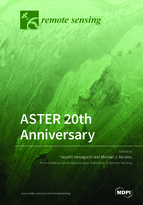ASTER 20th Anniversary
A special issue of Remote Sensing (ISSN 2072-4292). This special issue belongs to the section "Remote Sensing in Geology, Geomorphology and Hydrology".
Deadline for manuscript submissions: closed (31 October 2019) | Viewed by 67713
Special Issue Editors
Interests: remote sensing using data from ASTER and other optical sensor images for geological mapping; terrestrial vegetation monitoring; and heat balance analysis in urban centers
Interests: ASTER; Geologic Remote Sensing
Special Issue Information
Dear Colleagues,
The Advanced Thermal Emission and Reflection Radiometer (ASTER) is a research facility instrument on NASA’s Terra spacecraft. We will soon celebrate the 20th anniversary of ASTER since its launch in December 1999. ASTER has been providing high spatial resolution multispectral data in the VNIR, SWIR and TIR regions, and along-track stereo data. Starting April 2016, ASTER data have been distributed to the public at no cost. Another important and the most popular data set is the ASTER Global DEM, which covers almost the entire land surface at 30 m grid size. ASTER data have been widely used in a variety of application areas such as land surface mapping and change detection, volcano and other natural hazard monitoring, and urban heat island monitoring. This special issue will cover topics including scientific achievements using ASTER data, calibration activities to ensure long-term consistency of ASTER data, applications to a wide range of disciplines, and commercial and operational uses. We also encourage the submission of papers on individual scientific results obtained by using ASTER data.
Prof. Yasushi Yamaguchi
Mr. Michael J. Abrams
Guest Editors
Manuscript Submission Information
Manuscripts should be submitted online at www.mdpi.com by registering and logging in to this website. Once you are registered, click here to go to the submission form. Manuscripts can be submitted until the deadline. All submissions that pass pre-check are peer-reviewed. Accepted papers will be published continuously in the journal (as soon as accepted) and will be listed together on the special issue website. Research articles, review articles as well as short communications are invited. For planned papers, a title and short abstract (about 100 words) can be sent to the Editorial Office for announcement on this website.
Submitted manuscripts should not have been published previously, nor be under consideration for publication elsewhere (except conference proceedings papers). All manuscripts are thoroughly refereed through a single-blind peer-review process. A guide for authors and other relevant information for submission of manuscripts is available on the Instructions for Authors page. Remote Sensing is an international peer-reviewed open access semimonthly journal published by MDPI.
Please visit the Instructions for Authors page before submitting a manuscript. The Article Processing Charge (APC) for publication in this open access journal is 2700 CHF (Swiss Francs). Submitted papers should be well formatted and use good English. Authors may use MDPI's English editing service prior to publication or during author revisions.
Keywords
- ASTER
- ASTER long-term calibration
- Surface mapping by ASTER
- Change detection by ASTER
- ASTER GDEM







